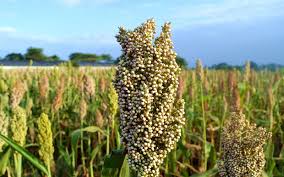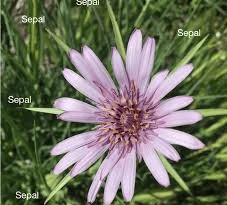Growing and Care Guide of Sorghum
Sorghum is a plant that people grow for many reasons. It is a grain, which means we can eat it. Farmers around the world plant sorghum because it’s useful and grows well in different places.
Farmers plant sorghum seeds in the soil, and the seeds grow into tall plants. These plants have long leaves and produce seeds at the top. People call these seeds sorghum grains. We can use sorghum grains to make food, like flour for bread or cereal.
Sorghum is special because it can grow in places where other plants might struggle. It doesn’t need as much water, so farmers in dry areas like to plant sorghum. This makes it an important crop for feeding people in places where water is scarce.
Not only is sorghum good for eating, but it’s also useful in other ways. Some people use sorghum to make sweet syrup. They crush the sorghum plants to get the juice, and then they cook it to make a tasty syrup. It’s a bit like making maple syrup from maple trees.
In some countries, people use sorghum to feed animals. Farmers find it helpful because it’s a nutritious food for their animals. It’s like a natural snack for cows, goats, and other animals on the farm.
Sorghum plants are tough and resilient. They can withstand harsh weather conditions, making them a reliable crop for farmers in different parts of the world. This toughness makes sorghum a smart choice for places where the weather can be unpredictable.
Sorghum is a versatile and valuable plant. People grow it for food, syrup, and animal feed. Its ability to thrive in various conditions makes it an important crop globally. Whether you enjoy a slice of sorghum bread or use it to sweeten your pancakes, this humble grain plays a big role in feeding communities worldwide.
Despite its simplicity, sorghum brings more to the table than just its use as food and syrup. In some places, people use sorghum to build things. The stalks of the sorghum plant are sturdy, and people weave them together to make fences or even simple structures. It’s like nature providing a building material for those who know how to use it.
Farmers also like sorghum because it helps the soil. When sorghum plants grow, their roots spread out and hold the soil together. This is good for the land because it prevents erosion, which is when the soil gets washed away by rain. So, in addition to being a reliable food source, sorghum is also a friend to the earth.
In many cultures, sorghum has a special place in traditions and celebrations. People might use sorghum in ceremonies or festivals, showcasing its cultural importance. It’s fascinating how a simple grain can connect people to their roots and traditions.
Furthermore, scientists are interested in sorghum because it has unique qualities. Some types of sorghum are resistant to pests, which means they don’t need as many chemicals to grow well. This is good for the environment and for the people who eat the sorghum because it reduces the amount of pesticides used in farming.
As the world changes, and we face challenges like climate change and growing populations, crops like sorghum become even more critical. Its ability to grow in tough conditions, its versatility in uses, and its role in sustainable agriculture make sorghum a crop worth exploring and celebrating.
In addition, sorghum is not just a grain; it’s a resilient plant that contributes to our food, culture, and environment. From the fields where it grows to our tables, sorghum quietly plays a significant role in the daily lives of many, embodying the beauty of simplicity and practicality.
Read Also: Rabbit Record Keeping and Analysis
Growing and Care Guide of Sorghum

Here are the key steps to follow in order to grow your Sorghum:
1. Planting: To grow sorghum, start by choosing a sunny spot in your garden. Sorghum loves sunlight, so make sure it gets plenty of it. When the soil is warm, usually in the spring, plant sorghum seeds about 1 to 2 inches deep. Leave enough space between the seeds to allow the plants to grow without crowding each other.
2. Watering: Sorghum is a hardy plant, but it still needs water to grow well. Water the sorghum plants regularly, especially during dry periods. However, be mindful not to overwater, as sorghum doesn’t like soggy soil. Aim for a balance, keeping the soil consistently moist but not waterlogged.
3. Soil: Sorghum is not too picky about soil, but it does best in well-draining soil. Adding some compost to the soil before planting can provide extra nutrients that help the sorghum plants thrive. If your soil is heavy or tends to retain water, consider adding sand to improve drainage.
4. Fertilizing: Sorghum doesn’t demand a lot of fertilizer, but a balanced, all-purpose fertilizer applied during the growing season can boost its growth. Follow the package instructions for application rates, and be cautious not to over-fertilize, as excessive nutrients can harm the plants.
5. Weeding: Keep the area around your sorghum plants free from weeds. Weeds compete with sorghum for nutrients and water, so regular weeding is essential. Be gentle when weeding to avoid disturbing the sorghum’s shallow roots.
6. Harvesting: The time to harvest sorghum depends on its intended use. If you’re growing it for grain, wait until the seeds are fully mature and have turned a deep shade. For sweet sorghum syrup, harvest when the stalks are still green but the seeds are in the dough stage. Cut the stalks at ground level when they’re ready.
7. Pests and Diseases: Sorghum is relatively resistant to pests, but it’s good to keep an eye out for common issues like aphids or grasshoppers. If you notice any pests, consider using natural methods or insecticidal soap to control them. Sorghum is also susceptible to certain diseases, so rotating crops and maintaining good garden hygiene can help prevent problems.
Whether you’re cultivating it for food, syrup, or as an ornamental plant, sorghum’s adaptability and low-maintenance nature make it a rewarding addition to your garden.
Uses of Sorghum

Below are some of the key uses of Sorghum:
1. Food Production: Sorghum is a staple food for millions of people worldwide. The grains can be ground into flour to make a variety of foods, including bread, porridge, and couscous. Its gluten-free nature also makes it a suitable alternative for those with gluten sensitivities.
2. Animal Feed: Sorghum is an essential component of animal feed. Its nutritional value makes it a popular choice for feeding livestock such as cows, pigs, and poultry. The stalks, leaves, and grain can all be utilized as feed, contributing to the health and well-being of farm animals.
3. Sweet Sorghum Syrup: Some varieties of sorghum are specifically cultivated for their sweet juice. Farmers crush the stalks to extract the juice, which is then boiled down to produce a thick, sweet syrup. This sorghum syrup serves as a natural sweetener for various culinary purposes.
4. Building Materials: The sturdy stalks of sorghum plants have been traditionally used to create fences, walls, and other simple structures. In some regions, sorghum stalks are woven together to form durable materials for construction, showcasing its versatility beyond agriculture.
5. Cultural and Traditional Uses: Sorghum holds cultural significance in many societies. It is often used in ceremonies, festivals, and rituals. The plant’s presence in traditional practices reflects its deep-rooted connection to the cultural heritage of communities that cultivate and cherish it.
6. Biofuel Production: Sorghum has gained attention as a potential biofuel crop. The stalks, which contain a high amount of cellulose, can be used to produce bioenergy through processes like fermentation and distillation. This aligns with efforts to explore sustainable and renewable energy sources.
7. Soil Erosion Prevention: The extensive root system of sorghum plants helps prevent soil erosion. When grown in areas prone to erosion, sorghum acts as a natural stabilizer, anchoring the soil with its roots and minimizing the risk of valuable topsoil being washed away.
8. Medical Uses: Some traditional medicinal practices involve the use of sorghum. While not a replacement for modern medicine, certain communities believe in the therapeutic properties of sorghum for various ailments.
9. Environmental Benefits: Sorghum’s ability to grow in diverse climates with minimal water requirements contributes to sustainable agriculture. Its cultivation can be part of strategies to adapt to changing environmental conditions and promote agricultural resilience.
In essence, sorghum’s adaptability and diverse uses make it a valuable crop with implications ranging from food security to cultural heritage and environmental sustainability. Its contributions extend beyond the dinner table, showcasing the importance of this resilient plant in various aspects of human life.
Read Also: Required Husbandry Skills of Rabbit Production
Economic Benefits of Sorghum

1. Global Food Security: Sorghum is a crucial food crop, providing sustenance for millions of people worldwide. Its ability to thrive in diverse climates contributes to global food security by offering a reliable source of nutrition, especially in regions with challenging agricultural conditions.
2. Livestock Industry Support: As a major component of animal feed, sorghum plays a vital role in supporting the livestock industry. Its use in feed formulations for cattle, poultry, and other animals helps ensure a stable and cost-effective food supply chain, impacting the economic viability of the livestock sector.
3. Income Generation for Farmers: Sorghum cultivation provides a source of income for farmers. The sale of sorghum grains, sweet sorghum syrup, and other sorghum-based products contributes to the economic well-being of farming communities. The demand for sorghum in various industries further enhances its market value.
4. Job Creation: The sorghum value chain, from cultivation to processing and distribution, creates employment opportunities. Farmers, laborers, and workers in processing facilities contribute to a network of jobs associated with sorghum production, benefiting both rural and urban economies.
5. Export Potential: Sorghum has export potential, contributing to international trade. Countries that produce surplus sorghum can export it to regions where the demand is high, fostering economic relationships and enhancing global trade dynamics.
6. Diversification of Agricultural Income: Including sorghum in a diverse crop portfolio allows farmers to spread risk and optimize income. Its ability to grow in conditions that might be challenging for other crops makes it a valuable addition to agricultural strategies, especially in regions susceptible to weather variations.
7. Biofuel Production and Energy Security: The use of sorghum in biofuel production contributes to energy security. As a renewable resource, sorghum offers an alternative source for bioenergy, potentially reducing dependence on non-renewable energy sources and mitigating the economic impact of energy fluctuations.
8. Sustainable Agriculture Practices: Sorghum’s resilience to drought and its potential to improve soil health contribute to sustainable agriculture practices. Implementing such practices can lead to cost savings for farmers, as well as long-term benefits for the environment and agricultural productivity.
9. Investment in Research and Development: The economic importance of sorghum has prompted research and development initiatives. Scientific advancements in sorghum cultivation, pest resistance, and processing techniques not only enhance yields but also stimulate innovation, creating opportunities for investment in the agricultural sector.
In summary, the economic benefits of sorghum extend beyond individual farms, impacting global food systems, creating jobs, fostering trade, and contributing to sustainable agricultural practices. The versatility of sorghum in different industries underscores its significance in supporting livelihoods and economic development.
Read Also: Design Criteria, Advantages and Disadvantages for Grit Removal









